I've had my Dragoon a few years and now the new Walker. I'm wondering if there's any common modifications or adjustments you might do to improve the actions.
I polished the internals, honed the forcing cone ( has rough edge from factory ), polished the bolt and I'll be filing the loading lever latch a little.
The Walker shoot very high, so I wonder what to do about that. Also, is it recommended to lighten up the mainspring in a Walker? It's a workout pulling that hammer back, but I know if it were too light, it might cause more cap fragment issues and allow more blowback/fouling from the nipples.
I don't expect the Walker to feel like my well tuned SAA, but I'd like to hear about any common modifications you do.
Also, without starting a whole thread; Do conicals improve accuracy in the Walker?
I polished the internals, honed the forcing cone ( has rough edge from factory ), polished the bolt and I'll be filing the loading lever latch a little.
The Walker shoot very high, so I wonder what to do about that. Also, is it recommended to lighten up the mainspring in a Walker? It's a workout pulling that hammer back, but I know if it were too light, it might cause more cap fragment issues and allow more blowback/fouling from the nipples.
I don't expect the Walker to feel like my well tuned SAA, but I'd like to hear about any common modifications you do.
Also, without starting a whole thread; Do conicals improve accuracy in the Walker?





